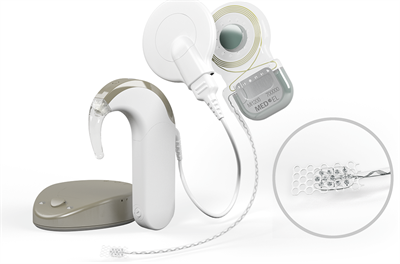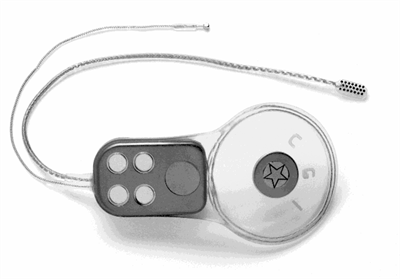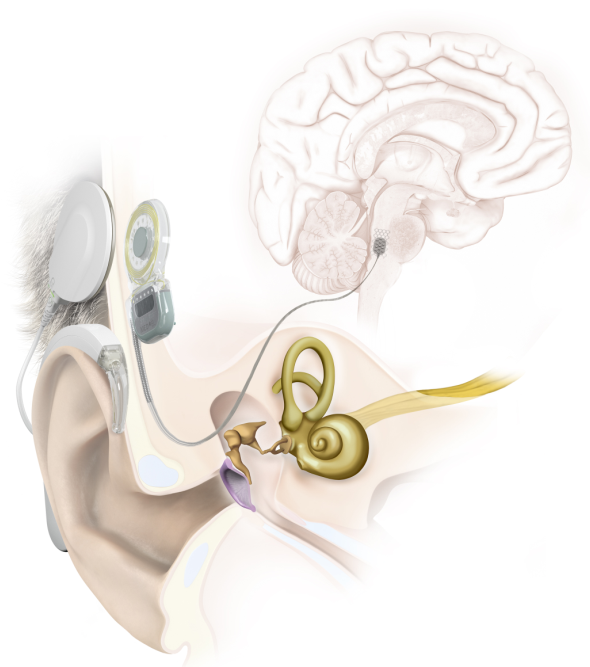Who is this service for?
People who have a bilateral profound sensorineural hearing loss (this means hearing loss in both ears that is 90dB or greater, where the root cause is the inner ear and/or the auditory nerve) and cannot understand speech through conventional hearing aids and who cannot have a cochlear implant.
Where do I need to go?
The service is based in the Hearing Implant Centre, 2nd floor, Lambeth Wing, St Thomas’ Hospital, Westminster Bridge Road, London, SE1 7EH.
What do I need to bring with me?
If your child uses hearing aids please bring these with you to the appointments. Please also bring:
- names and contact details of any other health professionals involved in your child's care
- a list of any medicines they take
Information about auditory brainstem implants (ABIs)
Having an ABI is an elective procedure. We'll share all the information and options available for you to make a fully informed decision.
The ear is made up of 3 parts, the outer (external) ear, the middle ear and the inner ear. The part we can see is the outer ear which also includes the ear canal. It functions to capture sound energy and funnel it to the ear drum. When the sound energy reaches the ear drum, it causes the ear drum to move and vibrate.
There are 3 tiny middle ear bones connected to the ear drum. When the ear drum vibrates, it causes the three bones to vibrate as well. As these bones vibrate, they push against the inner ear (cochlea).
The cochlea is a fluid filled organ which contains many sensory cells called hair cells. As the 3 bones push against the cochlea, the fluid inside of the cochlea begins to move which causes the hair cells to move and bend.
The hair cells contact the nerve of hearing (auditory nerve) and as they move and bend they stimulate the nerve. The nerve passes through the brainstem (cochlear nucleus) and transmits the electrical message to the brain where it is decoded by the auditory cortex into recognisable sounds.
The auditory brainstem implant (ABI) is an electronic device that is intended to restore a degree of hearing sensation for individuals with compromised inner ears and/or cochlear nerves.
An ABI might be considered for an adult who has lost or will lose hearing in both ears following the removal of bilateral acoustic tumours. It might also be considered for a child whose anatomy is such that a cochlear implant is not an option.
For both adult and children, sensations delivered by the ABI will support detection and identification of environmental sounds, as well as an aid to lip-reading. Individual outcomes are multifactorial and can vary significantly. The team provide recommendations on expected outcomes for your child.
Individuals will be assessed by a specialist multidisciplinary team who will consider hearing intervention options available for you or your child. Information surrounding alternative options to an ABI will be discussed with you if appropriate as well as what are likely future outcomes for you or your child should you choose not to go ahead with any surgical interventions.
The ABI consists of 2 parts.
One part is surgically implanted under the skin on the cochlear nucleus in the brainstem. This consists of an electrode array (placed on the cochlear nucleus) and a receiver stimulator (behind the ear under the skin).
The other part is worn externally behind the ear or as a body worn configuration and is referred to as a speech processor which is worn with a headpiece which is held in place on the head by a magnet. The external parts of the implant can be removed at any time, for example when sleeping or swimming and bathing.
The device works by the external speech processor powering the internal device and electrically stimulating the cochlear nucleus in the brainstem to produce a sensation of sound.
- Sound is picked up by the microphone behind the ear microphone.
- The speech processor filters and analyses the sounds and codes it into digital signals.
- The coded signals are sent along the cable to the transmitting coil.
- The transmitting coil sends the coded signals to the implant underneath the skin
- The implant delivers the signals to the electrodes on the cochlear nucleus
- The electrodes stimulate the cochlear nucleus, producing stimulation that may be interpreted as sound.
This whole process happens very quickly so that the ABI user will hear sounds as they occur.
Med EL Synchrony ABI and Sonnet Processor

Cochlear ABI

Placement of the ABI

The images above have been provided courtesy of Med EL.
You will have multiple appointments to establish if ABI is suitable for your child. These will include:
- checking their hearing
- assessing their communication, language and learning ability
- tests and scans (including Magnetic Resonance Imagining (MRI) and Computer Tomography (CT) scans)
- giving them a medical assessment
- appointments with the surgical team
- an information session which will be a chance for you to learn more about ABIs and ask questions
- Vibro-tactile aids (which do not require surgery)
- Performance very limited
- Sound detection and rhythm information
- Difficult to adjust to the different input
- Very often rejected by recipients
- Strap-on so no surgery required
- Cochlear Implant
- Only an option if inner ear and hearing nerve is present and functional
- Perception and understanding of sound is typically significantly greater than an ABI
- The team will inform you if a cochlear implant is a possible option. It is still possible to have an ABI even if a cochlear implant is in place
- No surgical intervention
- Some adult patients or families who are deciding on behalf of their child choose not to go ahead with surgical intervention and ABIs.
- For families with deaf children they would then choose a totally sign based communication route for their child. It is possible for a child to develop fluent language and a way to understand and communicate through sign language. British Sign Language (BSL) is the language used in the UK. If this option is chosen then families are encouraged to formally learn BSL and encourage as many family members as possible to also learn. Your child is likely to require a specialist education provision in which BSL is the main mode of communication used by children and staff. Even with an ABI it is recommended that sign language continues alongside trying to develop the child’s listening, understanding and use of spoken language.
The surgery consists of placing of the electrode array onto the cochlear nucleus in the brainstem, and placement of the receiver stimulator into the skull bone behind the ear. To assist with the placement of device the implant is stimulated during surgery and brain responses recorded via electrodes attached to the scalp. The operation lasts several hours.
You will meet with the surgeons who will discuss these with you. The risks of surgery are also describes in the booklet from the National Institute of Clinical Excellence (NICE) ‘Auditory Brainstem Implants’ (2005). These will be discussed with you in more detail when you meet the surgeons. There are also potential programming complications which will be described later in this document.
Recovery from the surgery varies from person to person. Appointments will be booked taking into account your circumstances. The external speech processor is usually fitted about 6 weeks after the implant operation. This is usually referred to as the “switch on” or “device activation” appointment. At this appointment the speech processor and headpiece are fitted and connected to a computer. The first programming session in carried out in a recovery suite as it is necessary to monitor the heart rate during the first programming session. All subsequent appointments are carried out in an outpatient clinic.
Measurements are made during the ‘switch-on’ to determine the levels of electrical current required to produce auditory sensations. As the cochlear nucleus is in the brainstem area, it is likely that electrical currents may spread and stimulate other nerves. It is not always possible to know before the switch on which electrodes will produce sensations of hearing or other sensations however measurements made at the time of implantation or at a subsequent point prior to activation will help the audiologist plan.
The current spread may produce some side effects such as a facial twitch or a tickle in the throat or sensations in the limbs.
The challenge for programming children is their inability to communicate sensations they may be having that are not visible to the professionals programming the device. The aim would be to minimise or eliminate side effects through programming but it is not possible to be sure with children that some non hearing sensations will remain undetected.
An ABI is only licensed by the company for use in adults. This is due to the inability of children to be able to offer feedback to the audiologist programming the device of non auditory sensations they may experience. It can be used in children but this is at the discretion of the surgeon, the team and with the permission of NHS England.
The ABI user will be awake throughout the programming sessions.
The audiologist will set the current levels to stimulate the implant as a “programme” and download this into the speech processor. Further programming sessions will be required as the week and months go by.
The degree of benefit cannot be guaranteed and varies from patient to patient. Published research studies relate to small numbers of patients. Outcomes relate to a range of factors including: surgical outcome (placement of electrodes), number of electrodes active and for children if they have any additional needs including learning difficulties or other medical conditions. In children who receive cochlear implants there is strong evidence base that age of implantation impacts significantly on outcomes. Age is likely to be another factor that contributes to outcomes post ABI for children.
Progress with the ABI may be very slow and it may take many months before we can see how much help the ABI can give and if this translates into any functional use of hearing. For adult patients, as they have a memory for spoken language, they may make progress at a faster rate as they can use their memory for sound to try and make sense of the sensation from the ABI. Adults are also able to give feedback to the audiologist for programming which children will struggle to do because of their age.
The challenges of providing access to sound and enough pitch perception to discriminate speech through ABI’s varies. It is therefore recommended for children that a sign based communication system is developed and used consistently within the family to support communication between parents and child. There is a strong possibility that signing will remain a dominant part of the child and families communication system in the longer term.
For adult patients the ABI is possibly an aid to lipreading and on some occasions it may be possible to follow simple speech without lipreading.
Ideas and guidance to support your child's listening development will be given in rehabilitation sessions. We will work with you to help your child get the most use and benefit from the ABI.
Results from research shows that individuals with ABI may be able to obtain the following benefits:
- detection of environmental sounds
- identification or recognising of some environmental sounds
- identifying single words out of a closed set (listening only)
- understanding some familiar phrases (listening only)
Additional benefits for children:
- increase of vocalisations
- use of word approximations in speech
- use of simple spoken phrases
Some of the limitations of using an ABI are:
- some patients may not be able to hear anything at all after the ABI
- patients receive other sensations when the device is activated such as a facial twitch, gag reflex, swallowing difficulties, as other non hearing nerves are stimulated by the electrical current. The audiologist may have to turn off certain electrodes if non-auditory stimulation is noticed. It is not going to be possible to guarantee that all no auditory stimulation in a child will be noticed and thus they may be receiving unwanted side effects from the ABI longer term.
Our relationship with King's College Hospital
We have teamed up with King’s College Hospital in a partnership known as King’s Health Partners Academic Health Sciences Centre. We are working together to give our patients the best possible care, so you might find we invite you for appointments at King’s. To make sure everyone you meet always has the most up-to-date information about your health, we may share information about you between the hospitals.